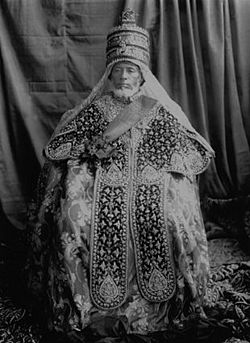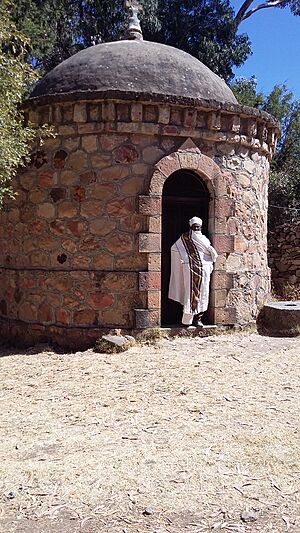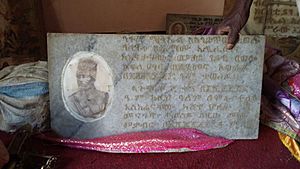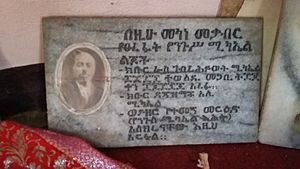Mikael of Wollo facts for kids
Quick facts for kids
Ras
Mikael of Wollo
|
|
|---|---|
 |
|
| Ras of Wollo | |
| Monarch | Yohannes IV Menelik II |
| Negus of Abyssinia | |
| Monarch | Lij Iyasu |
| Personal details | |
| Born |
Mohammed Ali
1850 Wollo, Ethiopian Empire |
| Died | 8 September 1922 (aged 71–72) Holeta, Shewa Province, Ethiopian Empire |
| Children | Lij Iyasu, Woizero Sihin of Wollo |
| Occupation |
|
| Military service | |
| Allegiance | |
| Battles/wars | First Italo-Ethiopian War
|
Negus Mikael of Wollo (born Mohammed Ali, 1850 – 8 September 1922) was a powerful leader in the Ethiopian Empire. He was a skilled army commander and a member of the nobility. He is known as the father of Emperor Lij Iyasu. He was also the grandfather of Empress Menen, who was the wife of Emperor Haile Selassie.
Mikael was born Mohammed Ali. He later changed his name to Mikael when he converted to Christianity. He had strong connections with two important emperors: Yohannes IV and Menelik II. Emperor Yohannes IV became his godfather. Emperor Menelik II became his father-in-law.
Mikael played a very important part in Ethiopian history. His army from Wollo was one of the strongest in northern Ethiopia. His cavalry, which were soldiers on horseback, were famous across the empire. He fought alongside Emperor Yohannes in the Battle of Gallabat against Sudanese forces. He was very loyal and held the dying Emperor Yohannes in his arms. Mikael also led his Wollo cavalry during the famous Battle of Adwa. In this battle, he fought with Emperor Menelik II and other key leaders.
Contents
Life Story of Mikael of Wollo
Early Life and Family
Mikael was born in a region called Wollo. His birth name was Mohammed Ali. His father was Imam Ali Abba Bula. He came from a powerful family in Wollo. His mother, Woizero Getie, was a Christian noblewoman. Mikael's family background showed the mix of different groups in Wollo.
Becoming a Christian
Emperor Yohannes IV held a meeting called the "Council of Boru Meda." At this meeting, he told Mohammed Ali and other Muslim leaders in Wollo to become Christians. They had three months to do so, or they would lose their positions of power. Mohammed Ali decided to convert to Christianity. He did this to keep his important role in Wollo.
However, most of the Muslim people in Wollo did not want to convert. They rebelled against the Emperor. Emperor Yohannes then led a military campaign in Wollo. Many Wollo Muslims were killed during this time. Mohammed Ali was baptized and given the Christian name "Mikael." He also received the title of Ras, which was like being a Duke. Many Muslims from Wollo left their homes to find safety in other areas.
Baptism and Marriage
Emperor Yohannes IV was Mikael's godfather during his baptism. After becoming Ras Mikael of Wollo, he married Shoaregga Menelik. She was Emperor Menelik's daughter. She became the third of Mikael's four wives.
Ras Mikael also founded the town of Dessie. This town became the new capital of Wollo. People say that Ras Mikael became a very religious Christian. He was a dedicated builder of churches.
Fighting at the Battle of Adwa
In 1896, Ethiopia was fighting the First Italo-Ethiopian War against Italy. Ras Mikael joined Emperor Menelik II in this war. He led his brave Wollo cavalry against the Italian invaders at the Battle of Adwa.
During the battle, an Italian army group tried to retreat. But they accidentally marched into a narrow valley. Mikael's cavalry attacked them there. They shouted "Reap! Reap!" as they fought. The Italian commander's body was never found after this battle.
The Battle of Segale
After Emperor Menelik II died in 1913, Mikael's son, Lij Iyasu, became the next leader. Iyasu was also Emperor Menelik's grandson. Menelik had wanted Ras Tessema Nadew to be the Regent (a temporary ruler) for Iyasu, who was 18. But Tessema Nadew died that same year.
Iyasu was now on his own, but he was never fully accepted as emperor. He was also never officially crowned. However, Iyasu instructed that his father, Mikael, be made Negus (King) of Wollo and Tigray. Negus Mikael then became the real power behind the throne.
During World War I, people worried about Iyasu's connections. They thought he might be supporting the Central Powers. They also worried he might convert to Islam. Because of these concerns, a group of nobles and church leaders removed Iyasu from power on September 27, 1916.
They then declared Mikael's sister-in-law, Woizero Zewditu, as the new Empress. She was another daughter of Menelik. At the same time, they named young Ras Tafari Makonnen as the new Regent and Heir. He would later become Emperor Haile Selassie I. Ras Tafari was married to Woizero (later Empress) Menen Asfaw. She was Negus Mikael's granddaughter through his daughter, Woizero Sehin Mikael.
Negus Mikael reacted quickly to his son Iyasu being removed from power. On October 7, 1916, Mikael left Wollo with an army of 80,000 men. He planned to invade Shewa and put his son back on the throne. Iyasu was supposed to join him with his own army.
On October 27, Negus Mikael faced the main army supporting Empress Zewditu at the Battle of Segale. Mikael attacked first. But his machine guns quickly ran out of bullets. His artillery (large guns) also stopped firing soon after. His soldiers on foot and on horseback charged directly into heavy enemy fire. The enemy was ready for their attacks.
Iyasu was delayed on his way to the battle. He arrived too late to help his father. He only saw that his father's army was defeated. Iyasu then ran away from the battlefield and went into hiding. Mikael was captured. He was placed under the care of Fitawrari Habte Giyorgis. Mikael was kept on an island in Lake Chabo.
After two and a half years, Mikael asked Empress Zewditu to be moved from the island. His request was granted. He was then placed under house arrest at Holeta Genet. This was a former country home of the late Emperor Menelik II. Mikael died there six months later. Because he was the grandfather of the Crown Prince's wife, the royal court held a full mourning ceremony for him.
Death and Burial
Negus Mikael died on September 8, 1922. His body was carried from Holeta to Tenta for burial. The king was buried in Tenta St Mikael Church.
A special building called a mausoleum is found near the church. It has a dome-shaped roof. King Negus Mikael was buried in this mausoleum. Two of his sons, Gebrehiwot Mikael and Ali Mikael, are also buried there. His sister, Yetemegn Mere'ed, is also buried with them.
See also
- List of field marshals
- Sultan Aba Jifar




